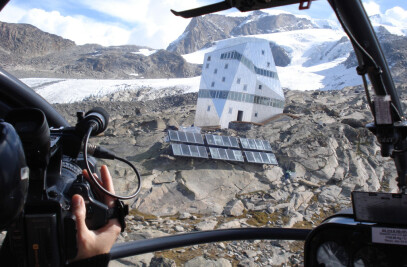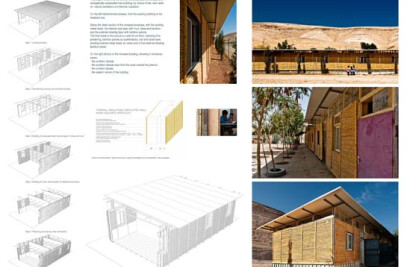Comment of the Holcim Awards jury Africa Middle East
The jury acknowledges the building’s design approach to be “sustainable by design”: sustainability being an architectural quality that emerges when a building responds to and integrates its social and physical environments in the development of its form and function to make effective and efficient use of resources. The project is an example of a holistic sustainable approach applicable in climatically challenging but technically sophisticated environments.
Project description by author
Sustainable by design - with the Swiss Village Sprinter Building in Masdar City we are trying to implement a holistic architectural design approach. Sustainability is not considered as a requirement, but as an architectural quality. The primary architectural design, the architectural elements and strategies have to be sustainable. Form and function cause each other.
Sustainable architecture is above all contextual architecture. The building refers to its climatic, morphological and spatial context as well as its cultural and social context. It is an integrated part of the city - open and permeable. The interaction with the context is multi-directional. The Sprinter Building profits from the shading of the surrounding buildings, from the high density, the mixed use and the good public infrastructure. But it also forms an integrated part of the city; it offers shady and naturally ventilated fresh public and semi-public spaces, a flexible and efficient building structure and diverse uses.
The plot is right next to the Masdar City Headquarters and should accommodate more than 20,000m2 of mixed use: 13,875m2 of flexible office space for the new Swiss Cleantech Hub, space for retail and gastronomy, the Swiss Embassy as well as the Swiss Ambassador’s Residence and 4,311m2 of residential use.
In a first step the general plot layout had to be defined. The distribution of the project brief across the site relates directly to the functions of the surrounding context. The office building is located to face adjacent commercial developments whilst the residential block faces proposed future residential developments. The ground level of the Sprinter Building is intended to be an active mix of retail and commercial use in order to enrich the public realm. Public access is provided via internal streets which all lead to a common public courtyard. The facades of the retail units at ground level are set back to provide a shaded street environment.
In a second step, the Sprinter Office Building had to be designed. The massing and architectural form of the site has been developed in response to the site gradients, prevailing afternoon wind direction, providing shading to the public realm and surrounding context. The general falls across the site lead to a stepping down in the building form. These steps have been linked to external courtyard spaces in order to drive the prevailing winds down to the public realm.
The building design is significant and unique. The use of traditional Arabic building typologies, elements and images form the basis for an intelligent and specific contemporary architectural expression, for the creation of emotional and recognizable spaces. Integration without subordination; atmosphere and identity instead of an iconic building design. Function, structure, materials and built form are mutually dependent, so as to combine the highest level of user comfort with a minimal use of resources and the lowest costs.
Innovation and transferability – Progress
Vernacular architecture meets Innovation - The used design strategy is linked closely to the local climatic conditions and the specific requirements of Masdar City. To optimize the outside climate around the building and in the public and private courtyards traditional passive design mechanisms are used. To be able to create a comfortable indoor climate passive design strategies (natural ventilation, solar chimneys, high thermal mass) are combined with highly effective active technologies (multi-service chilled beams with full enthalpy energy recovery). The methodology for the primary building design is based on vernacular design principles, that shall be further developed in cooperation with Kaisersrot, an ETH Zurich-Spin-Off able to build up parametric custom software solutions to optimize the build form and façade design. The courtyards have been sculpted as a result of CFD modeling to provide the optimum shape for the reduction of solar gain across the year.
Ethical standards and social equity – People
Masdar City has set up strict guidelines to ensure the quality of the working conditions on site. The design team has sourced locally available products for the buildings structure and envelope in order to drive down the carbon footprint and to support the local supply chain and construction economy. The use of contemporary rammed earth walls will help to rebuild the knowledge about earthen construction techniques and to educate local workers in UAE which has a rich earthen heritage.
Environmental quality and resource efficiency – Planet
The design strategy is adapted to the local climatic conditions and the specific requirements of Masdar City: Reduce embedded energy within the primary building construction (65% reduction in embodied carbon compared to a building with standard specification materials) Combination of passive and active climate design strategies to reduce energy consumption (-54.9% compared with Ashrae Baseline) Waste diverted from landfill (-60% compared with BAU) Water Demand Reduction (-51% compared with BAU).
Economic performance and compatibility – Prosperity
The building generates a high flexibility in use and a maximized NIA/GFA-ratio (85%) to be able to provide high quality office spaces with comparable market prices. A construction grid of 9.45m, an office module of 1.35m and a depth of 14.80/16.15m allow nearly every office typology (Single, Group, Combi or Open space offices). The use of the ESTIDAMA Pearl Building Rating System (PBRS) as part of the design process secures the efficient use of materials and low lifecycle costs.
Contextual and aesthetic impact – Proficiency
The urban design draws on traditional Arabic city forms to recreate and reinterpret a variety of spatial experiences across the site plot. These spaces form a sequence of public areas, common spaces and private courtyards and create a high level of privacy within a dense urban structure. The façade design refers to different aspects and requirements of the building: - minimize solar radiation and maximize natural daylight - provide direct views to the outside as well as a high level of privacy - reinterpret local ornamental façade design traditions The screen is made up from terracotta tiles with a bespoke pattern of holes.

































